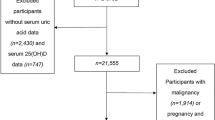Abstract
Summary
This study examines the relationship between obesity and the increase in serum 25(OH)D levels in response to vitamin D supplementation among adults with baseline serum 25(OH)D levels <50 nmol/L. This study revealed that the increase in serum 25(OH)D in response to vitamin D supplementation was higher in lean subjects as compared to obese subjects.
Introduction
Serum 25(OH)D is lower among obese than non-obese. This study examines the relationship between obesity and the increase in serum 25(OH)D in response to vitamin D supplementation in a large sample of adults with baseline serum 25(OH)D <50 nmol/L, relatively long average treatment duration and large average daily cholecalciferol.
Methods
The computerized database of the Clalit Health Services, which the largest nonprofit health maintenance organization in Israel, was retrospectively searched for all subjects aged ≥20 years who performed serum 25(OH)D test in 2011. Subjects with more than one test at different occasions in 2011 were identified and were included if the result of the first test was <50 nmol/L, and were treated with cholecalciferol between the first and the last test in 2011 (n = 16,540 subjects).
Results
The mean increase in serum 25(OH)D level after treatment was 28.7 (95 % confidence interval (CI), 28.0–29.4) nmol/L, 23.6 (23.0–24.2) nmol/L, and 20.1 (19.6–20.6) nmol/L in subject with BMI of <25, 25–29.9, and ≥30 kg/m2, respectively (P < 0.001). The results were similar after adjustment for the potential confounders. Similarly, the proportion of subjects who achieved serum 25(OH)D ≥ 50 nmol/L after treatment was inversely associated with BMI; 65.1, 58.3, and 49.1 % for BMI of <25, 25–29.9, and ≥ 30 kg/m2, respectively. Compared to BMI of ≥30 kg/m2, the adjusted odds ratio for achieving levels of ≥50 nmol/L were 2.12 (95 % CI, 1.94–2.31) and 1.42 (1.31–1.54) for BMI of <25 kg/m2, and BMI of 25–29.9 kg/m2, respectively.
Conclusions
BMI is inversely associated with the increase in serum 25(OH)D levels in response to vitamin D supplementation.

Similar content being viewed by others
References
Pearce SH, Cheetham TD (2010) Diagnosis and management of vitamin D deficiency. BMJ 340:142–147
Looker AC, Pfeiffer CM, Lacher DA, Schleicher RL, Picciano MF, Yetley EA (2008) Serum 25-hydroxyvitamin D status of the US population: 1988–1994 compared with 2000–2004. Am J Clin Nutr 88:1519–1527
Bolland MJ, Grey AB, Ames RW, Mason BH, Horne AM, Gamble GD, Reid IR (2007) The effects of seasonal variation of 25-hydroxyvitamin D and fat mass on a diagnosis of vitamin D sufficiency. Am J Clin Nutr 86:959–964
Wortsman J, Matsuoka LY, Chen TC, Lu Z, Holick MF (2000) Decreased bioavailability of vitamin D in obesity. Am J Clin Nutr 72:690–693
Holick MF (2007) Vitamin D deficiency. N Engl J Med 357:266–281
Dobnig H, Pilz S, Scharnagl H, Renner W, Seelhorst U, Wellnitz B, Kinkeldei J, Boehm BO, Weihrauch G, Maerz W (2008) Independent association of low serum 25-hydroxyvitamin d and 1,25-dihydroxyvitamin d levels with all-cause and cardiovascular mortality. Arch Intern Med 168:1340–1349
Wolden-Kirk H, Overbergh L, Christesen HT, Brusgaard K, Mathieu C (2011) Vitamin D and diabetes: its importance for beta cell and immune function. Mol Cell Endocrinol 347(1–2):106–120
Mattila C, Knekt P, Männistö S, Rissanen H, Laaksonen MA, Montonen J, Reunanen A (2007) Serum 25-hydroxyvitamin D concentration and subsequent risk of type 2 diabetes. Diabetes Care 30:2569–2570
Giovannucci E, Liu Y, Hollis BW, Rimm EB (2008) 25-Hydroxyvitamin D and risk of myocardial infarction in men: a prospective study. Arch Intern Med 168:1174–1180
Leu M, Giovannucci E (2011) Vitamin D: epidemiology of cardiovascular risks and events. Best Pract Res Clin Endocrinol Metabol 25:633–646
Ou HY, Karnchanasorn R, Lee LZ, Chiu KC (2011) Interaction of BMI with vitamin D and insulin sensitivity. Eur J Clin Invest 41:1195–1201
Lee P, Greenfield JR, Seibel MJ, Eisman JA, Center JR (2009) Adequacy of vitamin D replacement in severe deficiency is dependent on body mass index. Am J Med 122:1056–1060
Rajakumar K, Fernstrom JD, Holick MF, Janosky JE, Greenspan SL (2008) Vitamin D status and response to vitamin D(3) in obese vs. non-obese African American children. Obesity (Silver Spring) 16:90–95
National Academy of Science, Institute of Medicine (2011) Dietary references intake for calcium and vitamin D. http://www.nap.edu/catalog.php?record_id=13050. Accessed 1 Sept 2011
Ross AC, Manson JE, Abrams SA, Aloia JF, Brannon PM, Clinton SK, Durazo-Arvizu RA, Gallagher JC, Gallo RL, Jones G, Kovacs CS, Mayne ST, Rosen CJ, Shapses SA (2011) The 2011 report on dietary reference intakes for calcium and vitamin D from the Institute of Medicine: what clinicians need to know. J Clin Endocrinol Metab 96:53–58
Shoben AB, Kestenbaum B, Levin G, Hoofnagle AN, Psaty BM, Siscovick DS, de Boer IH (2011) Seasonal variation in 25-hydroxyvitamin D concentrations in the cardiovascular health study. Am J Epidemiol 174:1363–1372
Saliba W, Rennert HS, Kershenbaum A, Rennert G (2012) Serum 25(OH)D concentrations in sunny Israel. Osteoporos Int 23:687–694
Holick MF, Binkley NC, Bischoff-Ferrari HA, Gordon CM, Hanley DA, Heaney RP, Murad MH, Weaver CM, Endocrine Society (2011) Evaluation, treatment, and prevention of vitamin D deficiency: an Endocrine Society Clinical Practice Guideline. J Clin Endocrinol Metab 96:1911–1930
Conflicts of interest
None
Author information
Authors and Affiliations
Corresponding author
Rights and permissions
About this article
Cite this article
Saliba, W., Barnett-Griness, O. & Rennert, G. The relationship between obesity and the increase in serum 25(OH)D levels in response to vitamin D supplementation. Osteoporos Int 24, 1447–1454 (2013). https://doi.org/10.1007/s00198-012-2129-0
Received:
Accepted:
Published:
Issue Date:
DOI: https://doi.org/10.1007/s00198-012-2129-0




